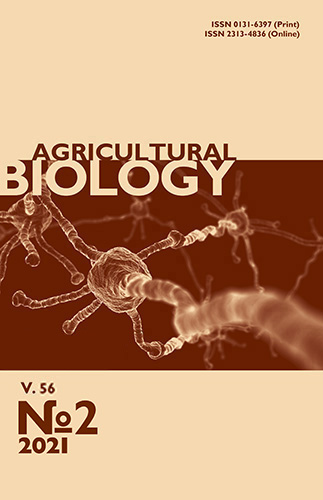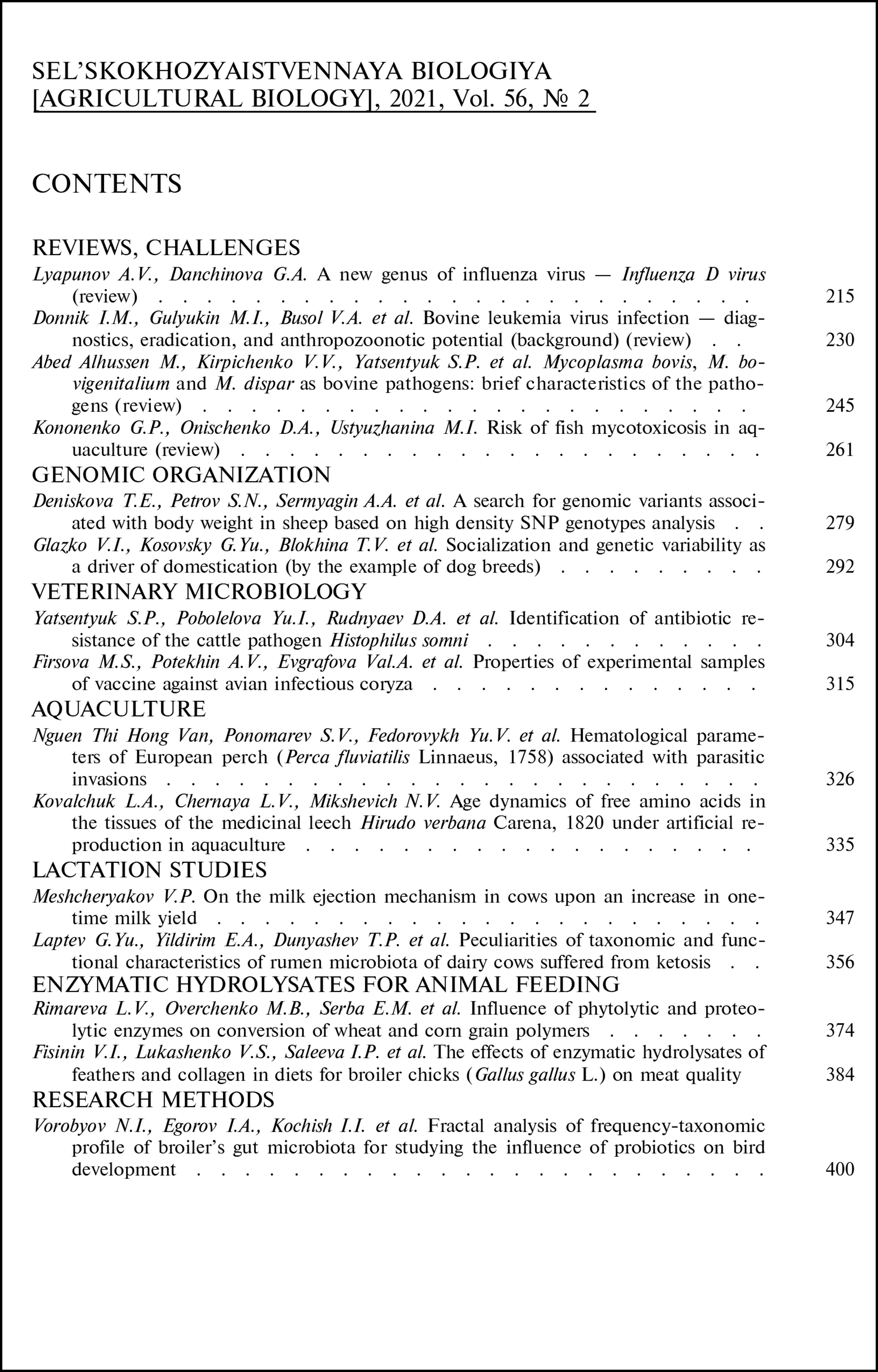doi: 10.15389/agrobiology.2021.2.400eng
UDC: 636.5258:579.6:51-76
Acknowledgements:
The study was carried out on the basis of the Federal Scientific Center All-Russian Research and Technological Poultry Institute RAS.
Supported financially by the Russian Science Foundation grant for the project No. 16-16-04089-P “Studying the physiological and microbiological characteristics of the digestion of chicken meat in the embryonic and postembryonic periods to create new feeding technologies that provide the fullest realization of the genetic potential of the bird”
FRACTAL ANALYSIS OF FREQUENCY-TAXONOMIC PROFILE OF BROILER’S GUT MICROBIOTA FOR STUDYING THE INFLUENCE OF PROBIOTICS ON BIRD DEVELOPMENT
N.I. Vorobyov1 ✉, I.A. Egorov2, I.I. Kochish3, I.N. Nikonov3,
T.N. Lenkova2
1All-Russian Research Institute for Agricultural Microbiology, 3, sh. Podbel’skogo, St. Petersburg, 196608 Russia, e-mail Nik.IvanVorobyov@yandex.ru (✉ corresponding author);
2Federal Scientific Center All-Russian Research and Technological Poultry Institute RAS, 10, ul. Ptitsegradskaya, Sergiev Posad, Moscow Province, 141311 Russia, e-mail Olga@vnitip.ru, dissovet@vnitip.ru;
3Skryabin Moscow State Academy of Veterinary Medicine and Biotechnology, 23, ul. Akademika K.I. Skryabina, Moscow, 109472 Russia, e-mail zoo-kafedra@yandex.ru, ilnikonov@yandex.ru
ORCID:
Vorobyov N.I. orcid.org/0000-0001-8300-2287
Nikonov I.N. orcid.org/0000-0001-9495-0178
Egorov I.A. orcid.org/0000-0001-9122-9553
Lenkova T.N. orcid.org/0000-0001-8026-3983
Kochish I.I. orcid.org/0000-0001-8892-9858
Received December 5, 2019
The article provides theoretical and empirical data about the probiotic effect on the microbiota bioconsolidation in the broiler intestines of the Smena cross. The results of such studies can be used to improve the quality and volume of meat products in large-scale production. The probiotics have been used to improve feed digestibility and accelerate bird development. To stimulate the transformation of plant substrates in the bird intestines, probiotics were used instead of antibiotics. The probiotics contained the bacteria Lactobacillus plantarum and Lactobacillus fermentum. The study goal is to develop a methodology for fractal analysis of the frequency-taxonomic profiles of operational taxonomic units (OTUs) of the microbiota into the bird intestines. Using the fractal methodology, the index of microbiom bioconsolidation of the bird intestines was calculated, which characterizes the biosystem self-organization of microflora and the efficiency of biochemical transformations of plant substrates in the bird intestines. In the experiment, the microflora was studied in one control and two experimental groups of birds. The OTUs profiles were obtained by the molecular genetic NGS method (Next Generation Sequencing). The key concept of fractal analysis of OTUs profiles was the concept of the elementary OTU fractal. The elementary OTU fractal is three OTUs, the frequencies of which form a geometric numerical sequence (for example, {0.5; 0.25; 0.125}). The OTU profiles may contain several elementary OTU fractals combined into one larger OTU megafractal. We assume that if the number of OTUs combined into the OTU megafractal increases, then biochemical transformations of plant substrate are carried out more efficiently and on a large scale, and the bird macroorganism receives more nutrients. Therefore, we define the bioconsolidation index of the broiler microbiome as the ratio of the number of OTUs in the OTU megafractal to the total number of OTUs in the OTU profiles. The fractal portraits of OTU profiles were used to identify elementary OTU fractals. The elementary OTU fractals were identified by the linear arrangement of three OTU images on fractal portrait. The fractal analysis confirmed that the bacterial probiotics increase the microbiom bioconsolidation in the bird intestines. The microbiome bioconsolidation index in the experimental groups of birds (0.82...0.86) was higher than this index in the control group of birds (0.55). According to the results of fractal analysis, probiotic No. 1 (with Lactobacillus plantarum) is not recommended for use, and probiotic No. 2 (with Lactobacillus fermentum) is recommended for use.
Keywords: frequency-taxonomic profile, fractal portrait, intestinal microbiota, biosystem consolidation index, broilers, dietary probiotics, Lactobacillus.
REFERENCES
- Torok V.A., Hughes R.J., Mikkelsen L.L., Perez-Maldonado R., Balding K., MacAlpine R., Percy N.J., Ophel-Keller K. Identification and characterization of potential performance-related gut microbiotas in broiler chickens across various feeding trials. Applied and Environmental Microbiology, 2011, 77(17): 5868-5878 CrossRef
- Sun H., Tang J.-W., Yao X.-H., Wu Y.-F., Wang X., Feng J. Effects of dietary inclusion of fermented cottonseed meal on growth, cecal microbial population, small intestinal morphology, and digestive enzyme activity of broilers. Trop. Anim. Health Prod., 2013, 45: 987-993 CrossRef
- Stanley D., Denman S.E., Hughes R.J., Geier M.S., Crowley T.M., Chen H., Haring V.R., Moore R.J. Intestinal microbiota associated with differential feed conversion efficiency in chickens. Appl. Microbiol. Biotechnol., 2012, 96: 1361-1369 CrossRef
- Brisbin J.T., Gong J., Orouji S., Esufali J., Mallick A.I., Parvizi P., Shewen P.E., Sharif S. Oral treatment of chickens with lactobacilli influences elicitation of immune responses. Clin. Vaccine Immunol., 2011, 18(9): 1447-1455 CrossRef
- Biggs P., Parsons C.M., Fahey G.C. The effects of several oligosaccharides on growth performance, nutrient digestibilities, and cecal microbial populations in young chicks. Poultry Science, 2007, 86(11): 2327-2336 CrossRef
- Chichlowski M., Croom J., McBride B.W., Daniel L., Davis G., Koci M.D. Direct-fed microbial PrimaLac and Salinomycin modulate whole-body and intestinal oxygen consumption and intestinal mucosal cytokine production in the broiler chick. Poultry Science, 2007, 86(6): 1100-1106 CrossRef
- Peng W.-X., Marchal J.L.M., van der Poel A.F.B. Strategies to prevent and reduce mycotoxins for compound feed manufacturing. Animal Feed Science and Technology, 2018, 237: 129-153 CrossRef
- Stanley D., Hughes R.G., Moore R. Microbiota of chicken gastrointestinal tract: influence on health productivity and disease. Applied Microbiology and Biotechnology, 2014, 98(10): 4301-4310 CrossRef
- Surai P.F. Polyphenol compounds in the chicken/animal diet: from the past to the future. Journal of Animal Physiology and Animal Nutrition, 2014, 98(1): 19-31 CrossRef
- Yang Ch., Chowdhury M.A.K., Hou Y., Gong J. Phytogenic compounds as alternatives to in-feed antibiotics: potentials and challenges in application. Pathogens, 2015, 4(1): 137-156 CrossRef
- Jamroz D., Wiliczkiewicz A., Wertelecki T., Orda J., Skorupińska J. Use of active substances of plant origin in chicken diets based on maize and locally grown cereals. British Poultry Science, 2005, 46(4): 485-493 CrossRef
- Vorob'ev N.I., Sviridova O.V., Popov A.A., Rusakova I.V., Petrov V.B. Graph-analysis in gene-metabolic networks of soil microorganisms which transformed plant residues to humus substances Sel'skokhozyaistvennaya biologiya, 2011, 3: 88-93 (in Russ.).
- Fisinin V.I., Il'ina L.A., Iyldyrym E.A., Nikonov I.N., Filippova V.A., Laptev G.Yu., Novikova N.I., Grozina A.A., Lenkova T.N., Manukyan V.A., Egorov I.A. Mikrobiologiya, 2016, 85(4): 472-480 CrossRef (in Russ.).
- Li J., Hao H., Cheng G., Liu C., Ahmed S., Shabbir M.A.B., Hussain H.I., Dai M., Yuan Z. Microbial shifts in the intestinal microbiota of Salmonella infected chickens in response to enrofloxacin. Frontiers in Microbiology, 2017, 8: 1711 CrossRef
- Wei S., Morrison M., Yu Z. Bacterial census of poultry intestinal microbiome. Poultry Science, 2013, 92(3): 671-683 CrossRef
- Pielsticker C., Glünder G., Rautenschlein S. Colonization properties of Campylobacter jejuni in chickens. European Journal of Microbiology and Immunology, 2012, 2(1): 61-65 CrossRef
- Lan Y., Verstegen M.W.A., Tamminga S., Williams B.A. The role of the commensal gut microbial community in broiler chickens. World’s Poultry Science Journal, 2005, 61(1): 95-104 CrossRef
- Wang Y., Sun J., Zhong H., Li N., Xu H., Zhu Q., Liu Y. Effect of probiotics on the meat flavour and gut microbiota of chicken. Scientific Reports, 2017, 7: 6400 CrossRef
- Lu J., Idris U., Harmon B., Hofacre C., Maurer J.J., Lee M.D. Diversity and succession of the intestinal bacterial community of the maturing broiler chicken. Applied and Environmental Microbiology, 2003, 69(11): 6816-6824 CrossRef
- Liao N., Yin Y., Sun G., Xiang C., Liu D., Yu H.D., Wang X. Colonization and distribution of segmented filamentous bacteria (SFB) in chicken gastrointestinal tract and their relationship with host immunity. FEMS Microbiology Ecology, 2012, 81(2): 395-406 CrossRef
- Bjerrum L., Engberg R.M., Leser T.D., Jensen B.B., Finster K., Pedersen K. Microbial community composition of the ileum and cecum of broiler chickens as revealed by molecular and cellular-based techniques. Poultry Science, 2006, 85(7): 1151-1164 CrossRef
- Louis P., Young P., Holtrop G., Flint H.J. Diversity of human colonic butyrate-producing bacteria revealed by analysis of the butyryl-CoA:acetate CoA-transferase gene. Environmental Microbiology, 2010, 12(2): 304-314 CrossRef
- Niba A.T., Beal J.D., Kudi A.C., Brooks P.H. Bacterial fermentation in the gastrointestinal tract of non-ruminants: influence of fermented feeds and fermentable carbohydrates. Tropical Animal Health and Production, 2009, 41(7): 1393-1407 CrossRef
- Bogatykh B.A. Fraktal'naya priroda zhivogo: sistemnoe issledovanie biologicheskoi evolyutsii i priroda soznaniya. Moscow, 2012 [Fractal nature of living things: systemic study of biological evolution and nature of consciousness] (in Russ.).
- Shreder M. Fraktaly, khaos, stepennye ryady. Izhevsk, 2001 [Fractals, chaos, power series] (in Russ.).
- Il’ina L.A., Iyldyrym E.A., Nikonov I.N., Filippova V.A., Laptev G.Yu., Novikova N.I., Grozina A.A., Lenkova T.N., Manukyan V.A., Fisinin V.I., Egorov I.A. Taxons of chicken cecum microbiom are abundant, and influenced by the combined feed composition and decreased metabolizable energy. Agricultural Biology [Sel'skokhozyaistvennaya biologiya], 2015, 50(6): 817-824 CrossRef
- Sviridova O.V., Vorobyov N.I., Provorov N.A., Orlova O.V., Rusakova I.V., Andronov E.E., Pishchik V.N., Popov A.A., Kruglov Yu.V. The alignment of soil’s conditions for plant’s development during microbial destruction of plant’s residues by microbial preparations. Agricultural Biology [Sel'skokhozyaistvennaya biologiya], 2016, 51(5): 664-672 CrossRef
- Orlova O.V., Andronov E.E., Vorobyov N.I., Kolodyazhnyi A.Yu., Moskalevskaya Yu.P., Patyka N.V., Sviridova O.V. Composition and functioning of microbial communities in the decomposition of straw cereals in sod podzolic soil. Agricultural Biology [Sel'skokhozyaistvennaya biologiya], 2015, 50(3): 305-314 CrossRef












